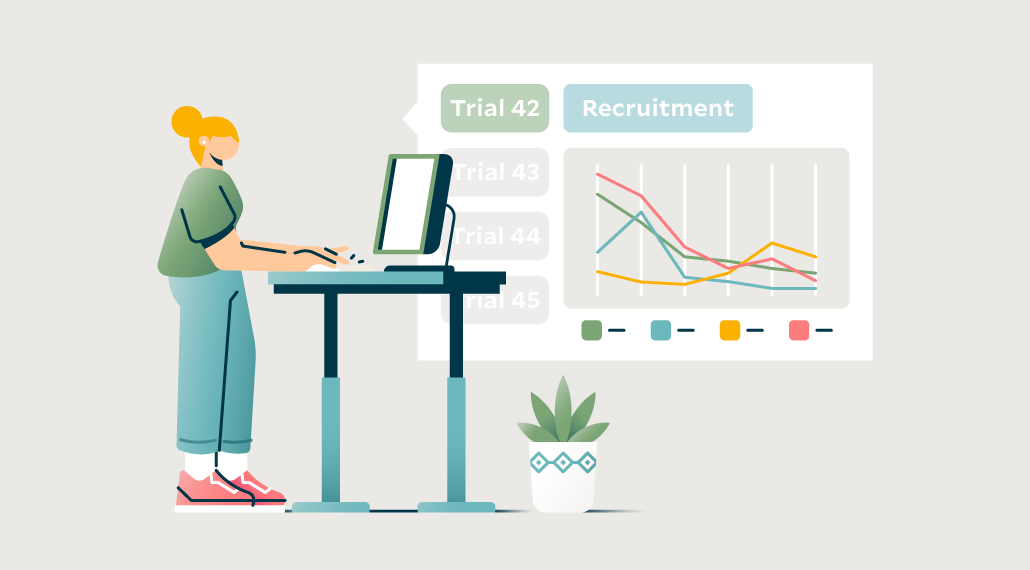February 7th, 2023
Why Pre-screening Data Matters in Clinical Trials That Are on Track with Enrollment
By OneStudyTeam

Even if your clinical trial enrollment is on track, it is still worthwhile to invest in making recruitment the smoothest–and fastest–it can be. Optimizing your approach with deeper data collection and secure sharing can ensure continued success, preventing a loss of time, money, and efficiency at any point in the trial. Investing in pre-screening data tracking early during clinical trials can help both sites and sponsors do their best work.
How can sites benefit from tracking pre-screening data?
If sites follow a pre-screening process in their clinical trials, the traditional tracking method has been jotting down names on Post-It notes or in assorted spreadsheets. This might be manageable for day-to-day workflows, but these disjointed and informal patient identification approaches prevent access and use of this data on a wider, more meaningful level as the trial continues. Rather than just tracking patients’ names and contact information, develop a standardized yet simple system for tracking details beyond that can give a more nuanced picture of recruitment for current and future trials. The kinds of patient details to consider collecting include:
-
Inclusion/exclusion criteria failures
-
Demographics such as age and race/ethnicity
-
Research indications and diagnoses
-
Reasons for voluntary dropout from trial participation
When sites and sponsors use a digital tracking system in their workflows to save this clinical trial data, they build out a record of pre-screening and screening failures and successes. For StudyTeam enrollment management platform users, these records can also be key for preventing any eligible candidate from falling through the cracks when doing any patient identification activities. Even if a patient fails pre-screening or screening for one study, their data can be used to identify them for other suitable trials.
Additionally, by capturing data from both successful and unsuccessful pre-screens and screens, a tracking system provides a record of a site’s activity that supports bids for future trials. Sites can provide appropriate data indicative of their performance to make them more competitive to sponsors, especially those who prioritize enrollment visibility.
Some sites may be hesitant to integrate a pre-screening tracking system into their already busy workflows. Rather than just another step for burdened coordinators and staff to keep in mind, systematic tracking with a digital tool can make workflows more efficient. Centralizing pre-screening and screening patient data in one place can encourage teamwork and collaboration within a site and improve relationship dynamics between sites and sponsors. By transparently sharing de-identified data in real time, sponsors are kept informed of activity and recruitment pacing at sites without having to check in as often through emails and phone calls.
Why should sponsors invest in tracking data as part of their pre-screening process in clinical trials?
Even if enrollment is on track, clinical trial data insights from this phase can help sponsors make decisions that optimize future trials portfolio-wide. It can also help them understand how best to support sites where enrollment may not be on track. But useful data insights are impossible to generate without data collection systems in place. By implementing pre-screening tracking at sites, sponsors can see which recruitment or referral channels are delivering qualified candidates to ensure they’re getting a desirable return on their investment. These insights on recruitment methods and channels can inform steps to invest in the right partners and processes.
Centralized pre-screening and screening data can reveal specific reasons that candidates are failing in the funnel, such as inclusion/exclusion criteria. While this may not affect enrollment success at one site, analyzing this data can help sponsors decide if a protocol amendment with more flexible criteria could improve the enrollment timelines at other sites connected to the same trial. This can improve the overall enrollment funnel of the trial.
Clinical trial diversity is a critical priority for stakeholders across the industry as well. A trial that does not enroll a representative patient population comes down to which patients did not enroll. Without pre-screening tracking data, sponsors only get nuanced details about who successfully enrolls in the trial. By taking a closer look at the top of the enrollment funnel, sponsors can get diversity data earlier, see what patient demographics are not enrolling and why, and help to ensure success in candidate quantity and quality.
Adopting a system to digitally track pre-screening data
While setting up pre-screening tracking is an investment of time, it's one of the clinical trial enrollment strategies that pays off in the long run for sites, sponsors, and patients alike. The benefits of a tracking system can be considered as an add-on to trial success rather than just a solution to a problem. Organized, collaborative, and informed trials can provide actionable data while improving workflows, helping site staff focus on what really matters: the patients.
Even if an enrollment timeline is on track, implementing pre-screening data collection can help sponsors and sites reach enrollment goals ahead of schedule and plan more effectively for future trials. The result? More efficient trials that get critical therapies to patients even faster.
Related Posts

How Does a Trial Manager in Greece Improve Clinical Trial Operations with StudyTeam®?
Dimitris Tziogas, local trial manager at a biotechnology company in ...
Read More
How to Address Key Clinical Trial Challenges, According to Clinresco Centres in South Africa
There’s no single solution to overcoming a research site’s specific ...
Read More
3 Clinical Trial Billing Challenges Research Sites Solve with StudyTeam
Challenge 1: Complicated coverage analysis Challenge 2: Tedious budgeting ...
Read More

.png?width=64&name=OST%20Transparent%20(1).png)